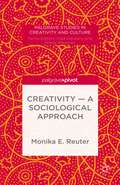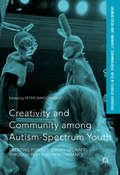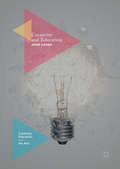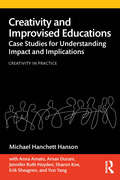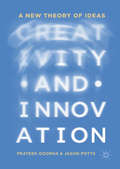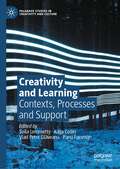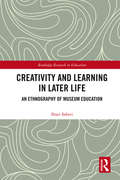- Table View
- List View
Creativity: Theories and Themes: Research, Development, and Practice
by Mark A. RuncoAn integrative introduction to the theories and themes in research on creativity, the second edition of Creativity is both a reference work and text for courses in this burgeoning area of research. The book begins with a discussion of the theories of creativity (Person, Product, Process, Place), the general question of whether creativity is influenced by nature or nurture, what research has indicated of the personality and style of creative individuals from a personality analysis standpoint, and how social context affects creativity. This wide-ranging work then proceeds to coverage of issues such as gender differences, whether creativity can be enhanced, if creativity is related to poor mental or physical health, and much more. The book contains boxes covering special interest items, including one-page biographies of famous creative individuals, and activities for a group or individual to test or encourage creativity, as well as references to Internet sites relating to creativity. - Includes all major theories and perspectives on creativity - Consolidates recent research into a single source - Includes key terms defined and text boxes with interesting related material - Single authored for clarity and consistency of presentation
Creativity — A New Vocabulary (Palgrave Studies in Creativity and Culture)
by Vlad Petre Glăveanu Lene Tanggaard Charlotte WegenerCreativity — A New Vocabulary proposes a novel approach to the way in which we talk and think about creativity. It covers a variety of topics not commonly associated with creativity that offer us valuable insights and open up new and exciting possibilities for creative action. This second edition includes six new essays which continue to challenge the traditional vocabulary of creativity and its preference for individuals, brains, cognition, personality, divergent thinking, insight, and problem solving. The book proposes a more dynamic and relational perspective that considers creativity as an embodied, social, material, and cultural process. This book will be useful for a wide range of specialists within the humanities and social sciences, as well as practitioners from applied fields who are looking for novel ways, of thinking about and doing creative work.
Creativity — A New Vocabulary (Palgrave Studies in Creativity and Culture)
by Lene Tanggaard Charlotte Wegener Vlad Petre GlaveanuThis book covers topics not commonly associated with creativity that offer us insight into creative action as a social, material, and cultural process. A wide range of specialists within the humanities and social sciences will find this interesting, as well as practitioners who are looking for novel ways of thinking about and doing creative work.
Creativity — A Sociological Approach (Palgrave Studies in Creativity and Culture)
by Monika E. ReuterIntroducing the first macro-sociological perspective on the concept of creativity this book includes a review of ten domains which have studied creativity. It also explores the results of a six-year on-going research project comparing students' ideas on creativity with employers' and industry professionals' views.
Creativity and Community among Autism-Spectrum Youth: Creating Positive Social Updrafts through Play and Performance (Palgrave Studies In Play, Performance, Learning, and Development)
by Peter SmagorinskyThis edited volume explores the roles of socially-channeled play and performance in the developmental trajectories of young people who fall on the autism spectrum. The contributors offer possibilities for channels of activity through which youth on the autism spectrum may find acceptance, affirmation, and kinship with others. "Positive social updraft" characterizes the social channels through which people of difference might be swept up into broader cultural currents such that they feel valued, appreciated, and empowered. A social updraft provides cultural meditational means that include people in a current headed "upward," allowing people of atypical makeups to become fully involved in significant cultural activity that brings them a feeling of social belonging.
Creativity and Creative Industries in Regional Australia: Interconnected Networks, Shared Knowledge and Choice Making Agents (Palgrave Studies in Creativity and Culture)
by Phillip McIntyre Susan Kerrigan Janet Fulton Evelyn King Claire WilliamsThis book explores the relationship between creativity, creative people, and creative industries in regional Australia through examining lived experience. The authors draw on more than 100 qualitative interviews with creative workers, and contextualise this creative work within the broader social and cultural structures of Australia’s Hunter region (located north of Sydney, in New South Wales). An invaluable resource for anyone interested in creative ecosystems as well as creativity and innovation, this book is an ethnographic study using the Hunter region as a case connected to the national and global networks that typify the creative industry. This timely addition to the Palgrave Studies in Creativity and Culture series gives a unique insight into creativity and cultural production.
Creativity and Development (Counterpoints: Cognition, Memory, and Language)
by R. Keith Sawyer Vera John-Steiner Seana Moran Robert J. Sternberg David Henry Feldman Howard Gardner Jeanne Nakamura Mihaly CsikszentmihalyiWhat is creativity, and where does it come from? Creativity and Development explores the fascinating connections and tensions between creativity research and developmental psychology, two fields that have largely progressed independently of each other-until now. In this book, scholars influential in both fields explore the emergence of new ideas, and the development of the people and situations that bring them to fruition. The uniquely collaborative nature of Oxford's Counterpoints series allows them to engage in a dialogue, addressing the key issues and potential benefits of exploring the connections between creativity and development. Creativity and Development is based on the observation that both creativity and development are processes that occur in complex systems, in which later stages or changes emerge from the prior state of the system. In the 1970s and 1980s, creativity researchers shifted their focus from personality traits to cognitive and social processes, and the co-authors of this volume are some of the most influential figures in this shift. The central focus on system processes results in three related volume themes: how the outcomes of creativity and development emerge from dynamical processes, the interrelation between individual processes and social processes, and the role of mediating artifacts and domains in developmental and creative processes. The chapters touch on a wide range of important topics, with the authors drawing on their decades of research into creativity and development. Readers will learn about the creativity of children's play, the creative aspects of children's thinking, the creative processes of scientists, the role of education and teaching in creative development, and the role of multiple intelligences in both creativity and development. The final chapter is an important dialogue between the authors, who engage in a roundtable discussion and explore key questions facing contemporary researchers, such as: Does society suppress children's creativity? Are creativity and development specific to an intelligence or a domain? What role do social and cultural contexts play in creativity and development? Creativity and Development presents a powerful argument that both creativity scholars and developmental psychologists will benefit by becoming more familiar with each other's work.
Creativity and Education (Creativity, Education and the Arts)
by Anne HarrisThis book advances an environmental approach to enhancing creativity in schools, by interweaving educational creativity theory with creative industries environmental approaches. Using Anna Craft’s last book Creativity and Education Futures as a starting point, the book sets out an up-to-date argument for why education policy should be supporting a birth-to-workplace approach to developing creative skills and capacities that extends across the education lifespan. The book also draws on the voices of school teachers, students and leaders who suggest directions for the next generation of creative teachers and learners in a rapidly evolving global education landscape. Overall, the book argues that secondary schools must find a way to make more room for creative risk, innovation and imagination in order to adequately prepare students for creative workplaces and publics.
Creativity and Entrepreneurial Performance: A General Scientific Theory (Exploring Diversity in Entrepreneurship)
by W. Edward McMullan Thomas P. KenworthyThe essential problem in entrepreneurship is improving the performance of entrepreneurs. The most important theories will be the ones that most enable us to predict and then ultimately influence entrepreneurial performance. This book develops a new and more accurate theory of entrepreneurial performance based in entrepreneurial creativity. The field of entrepreneurship has a long tradition of expecting entrepreneurial performance to be influenced by creativity, tracing back even before the pioneering work of Joseph Schumpeter (1883 to 1950), who defined entrepreneurship as creative-destruction—creating the new by supplanting or destroying the old. Subsequently, psychologist Robert Sternberg defined creativity as broadly encompassing creative aspects of personality, motivation, intellect, thinking style and relevant knowledge. Using Sternberg’s definition of creativity, the authors reviewed the evidence directly linking entrepreneurial creativity and entrepreneurial performance, concluding that the linkage is both statistically and practically significant. In order to scientifically tie entrepreneurship to creativity the book pursues a number of major objectives: In parts one and two, the authors remind us of our scientific challenge in the light of the depressing levels of performance typically to be found in the real world of entrepreneurship and explores the limitations of the dominant paradigms driving research in the field of entrepreneurship today. In part three, they bring together existing evidence to demonstrate the predictive and explanatory powers of creativity in relation to entrepreneurship. In part four, they further explore correlations between creativity and entrepreneurial performance at the individual and macro or society, levels. In summary, the book offers a bold predictive theory linking entrepreneurial creativity to entrepreneurial performance, however neither as boldly as a definitional linkage nor as timidly as one in a hundred or so factors potentially explaining entrepreneurial performance. This result is a general scientific theory that offers a serious challenge to entrepreneurial scholars who are pursuing other means for understanding the causality of entrepreneurial performance.
Creativity and Humour in Occupy Movements: Intellectual Disobedience in Turkey and Beyond
by Altug YalcintasThis volume offers scholarly perspectives on the creative and humorous nature of the protests at Gezi Park in Turkey, 2013. The contributors argue that these protests inspired musicians, film-makers, social scientists and other creative individuals, out of a concern for the aesthetics of the protests, rather than seizure of political power.
Creativity and Improvised Educations: Case Studies for Understanding Impact and Implications (Creativity in Practice)
by Michael Hanchett HansonExamining the improvised relationships among lifelong learning, formal education, and creativity, this volume provides detailed case studies of the creative work of people from a wide variety of fields. Each profile allows readers to explore how real people’s distinctive points of view, senses of purpose, and ultimate contributions developed through participation in complex worlds. By looking at creativity as a distributed and participatory process, these cases deconstruct the myth of solitary creative genius, while exploring applications of complexity theory to creative work and raising new questions for creativity research. Providing a framework for thinking about education, agency, and change, this book is valuable for both students and researchers seeking concrete ways to broaden their understanding of creativity in practice.
Creativity and Improvised Educations: Case Studies for Understanding Impact and Implications (Creativity in Practice)
by Michael Hanchett HansonExamining the improvised relationships among lifelong learning, formal education, and creativity, this volume provides detailed case studies of the creative work of people from a wide variety of fields. Each profile allows readers to explore how real people’s distinctive points of view, senses of purpose, and ultimate contributions developed through participation in complex worlds. By looking at creativity as a distributed and participatory process, these cases deconstruct the myth of solitary creative genius, while exploring applications of complexity theory to creative work and raising new questions for creativity research. Providing a framework for thinking about education, agency, and change, this book is valuable for both students and researchers seeking concrete ways to broaden their understanding of creativity in practice.
Creativity and Innovation: A New Theory of Ideas
by Jason Potts Prateek GoorhaIdeas are ubiquitous. They are the fundamental building blocks for all aspects of life. Yet, efforts to use ideas as a basic unit of analysis in a shared framework are rare. We often find it difficult to look past the artificial boundaries that academic disciplines and specialist fields of knowledge construct. In this book, the authors address this substantial lacuna by proposing an intuitive theory of ideas that serves as a trans-disciplinary basis for studying innovation and creativity. The theory proposed shows how new ideas emerge from contexts that rely on mechanisms, which were originally built on older and more central ideas. It demonstrates how these mechanisms help instantiate different perspectives on the same idea in variegated manners. By applying their theory to a variety of bat and ball sports, the authors illustrate the role that primitive ideas have on sports innovation, and explore further avenues for employing the theory in a number of different situations. This original book will be of interest to anyone who wishes to gain a deeper understanding of the processes of innovation and creativity, developed within a complex framework of ideas.
Creativity and Innovation in Organizations: Current Research and Recent Trends in Management
by José Ramos, Neil Anderson, José M. Peiró and Fred ZijlstraThis book reflects on the increasing variety of perspectives in organizational innovation research, paying attention to the antecedents, but also to the outcomes, of innovation. Some chapters analyze the ‘dark side’ of innovation, including the potential negative consequences of innovative behaviors, or of defying the innovation maximization fallacy. Others explicitly consider affective responses after innovation efforts, and assume that positive or negative effects rely on the context in which innovations occur, and on the way in which people manage the process of innovation. Several contributions adopt the dialectic approach by considering the multiple pathways and mechanisms that could lead to innovation at organizations. Most of the chapters include the interaction of actors’ characteristics (from employees or teams) together with situational constraints from the task or the social context, and outline the relevance of processes like team learning; motivation variables like basic need satisfaction; congruence of motives or meaningfulness at work; dynamics of communication networks; and affective variables. This edited collection offers a rich picture of current research and management trends in the field and contributes constructively toward promoting the dialectic perspective on creativity and innovation in the workplace. This book was originally published as a special issue of the European Journal of Work and Organizational Psychology.
Creativity and Innovation in Organizations (SIOP Organizational Frontiers Series)
by Michael D. Mumford E. Michelle ToddThis volume presents a distinctly multilevel perspective on creativity and innovation that considers individual-level, team-level, and firm-level factors. In illustrating these factors, this volume presents both theoretical and practical implications to guide researchers and practitioners alike in the continued study and advancement of creativity and innovation in organizations. Chapter authors not only discuss the abilities, personality, and motivational attributes that contribute to employee creativity, but they also address the impact of leadership and climate on creative performance in teams. Subsequently, firm-level influences such as planning, learning, strategy, and professions that influence the success of creative and innovative efforts are examined. With contributions from leading scholars around the globe, this book offers a comprehensive review of creativity and innovation to assist researchers and practitioners in their quests to understand and improve organizational creativity and innovation. This is an essential resource for scholars, researchers, or graduate students interested in creativity, innovation, and organizational behavior.
Creativity and Innovation in Organizations (SIOP Organizational Frontiers Series)
by Michael D. Mumford E. Michelle ToddThis volume presents a distinctly multilevel perspective on creativity and innovation that considers individual-level, team-level, and firm-level factors. In illustrating these factors, this volume presents both theoretical and practical implications to guide researchers and practitioners alike in the continued study and advancement of creativity and innovation in organizations. Chapter authors not only discuss the abilities, personality, and motivational attributes that contribute to employee creativity, but they also address the impact of leadership and climate on creative performance in teams. Subsequently, firm-level influences such as planning, learning, strategy, and professions that influence the success of creative and innovative efforts are examined. With contributions from leading scholars around the globe, this book offers a comprehensive review of creativity and innovation to assist researchers and practitioners in their quests to understand and improve organizational creativity and innovation. This is an essential resource for scholars, researchers, or graduate students interested in creativity, innovation, and organizational behavior.
Creativity and Innovation in Organizations: Current Research and Recent Trends in Management
by José Ramos Neil Anderson José M. Peiró Fred ZijlstraThis book reflects on the increasing variety of perspectives in organizational innovation research, paying attention to the antecedents, but also to the outcomes, of innovation. Some chapters analyze the ‘dark side’ of innovation, including the potential negative consequences of innovative behaviors, or of defying the innovation maximization fallacy. Others explicitly consider affective responses after innovation efforts, and assume that positive or negative effects rely on the context in which innovations occur, and on the way in which people manage the process of innovation. Several contributions adopt the dialectic approach by considering the multiple pathways and mechanisms that could lead to innovation at organizations. Most of the chapters include the interaction of actors’ characteristics (from employees or teams) together with situational constraints from the task or the social context, and outline the relevance of processes like team learning; motivation variables like basic need satisfaction; congruence of motives or meaningfulness at work; dynamics of communication networks; and affective variables. This edited collection offers a rich picture of current research and management trends in the field and contributes constructively toward promoting the dialectic perspective on creativity and innovation in the workplace. This book was originally published as a special issue of the European Journal of Work and Organizational Psychology.
Creativity and Learning: Contexts, Processes and Support (Palgrave Studies in Creativity and Culture)
by Vlad Petre Glăveanu Soila Lemmetty Kaija Collin Panu ForsmanThis book focuses on the relations and connections between creativity and learning in different contexts. By shifting the focus from individual psychology to a sociocultural framework, it explores the multidimensional nature of the processes under study, resulting in a ‘bigger picture’ of creativity and learning and their interdependence. The book examines the sociocultural definitions of creativity and learning in the contexts of children’s education and adult education, as well as workplaces and organisations. It offers insights concerning the frameworks and practices developed to enhance creativity and learning in different applied contexts. This collection brings together experts from across the globe and combines theoretical understandings, recent empirical findings and practical tools to be used by researchers, students and teaching staff, as well as practitioners, educators and managers. The book is a comprehensive, research-based volume on creativity and learning and their dynamic interconnection in various spheres of our life.
Creativity and Learning in Later Life: An Ethnography of Museum Education (Routledge Research in Education)
by Shari SabetiCreativity and Learning in Later Life examines how processes such as ‘creativity’ and ‘inspiration’ are experienced by writers who engage with the visual arts, and questions how age is perceived in relation to these processes. The author’s careful analysis challenges many of the assumptions on which museum education currently operates, contributing to wider debates surrounding the value of arts and cultural heritage education. Containing detailed descriptions of museum tours, viewers’ engagements with specific artworks, and the processes of creative writing and editing that result from such encounters, the book draws on a ground-breaking study to challenge the way in which the value of education and creative activity for older adult learners has been conceptualized in existing literature. It also demonstrates how learners adapt and subvert the intended pedagogies to suit their own needs and accommodate their ageing selves. Drawing on a spectrum of disciplines including education, anthropology, art history, sociology, museum studies and the practice and theory of creative writing, this book will be of interest to academics, postgraduate students, and researchers in a range of fields, as well museum practitioners, creative writing teachers and those working in adult and community education settings.
Creativity and Learning in Later Life: An Ethnography of Museum Education (Routledge Research in Education)
by Shari SabetiCreativity and Learning in Later Life examines how processes such as ‘creativity’ and ‘inspiration’ are experienced by writers who engage with the visual arts, and questions how age is perceived in relation to these processes. The author’s careful analysis challenges many of the assumptions on which museum education currently operates, contributing to wider debates surrounding the value of arts and cultural heritage education. Containing detailed descriptions of museum tours, viewers’ engagements with specific artworks, and the processes of creative writing and editing that result from such encounters, the book draws on a ground-breaking study to challenge the way in which the value of education and creative activity for older adult learners has been conceptualized in existing literature. It also demonstrates how learners adapt and subvert the intended pedagogies to suit their own needs and accommodate their ageing selves. Drawing on a spectrum of disciplines including education, anthropology, art history, sociology, museum studies and the practice and theory of creative writing, this book will be of interest to academics, postgraduate students, and researchers in a range of fields, as well museum practitioners, creative writing teachers and those working in adult and community education settings.
Creativity and Public Policy: Generating Super-optimum Solutions
by Stuart S NagelThis title was first published in 2000: A history of the ideas behind public policy studies, which can be defined as the study of the nature, causes and effects of government decisions for dealing with social problems.
Creativity and Public Policy: Generating Super-optimum Solutions
by Stuart S NagelThis title was first published in 2000: A history of the ideas behind public policy studies, which can be defined as the study of the nature, causes and effects of government decisions for dealing with social problems.
Creativity and resistance in a hostile world
by Sarita Malik Churnjeet Mahn Michael Pierse Ben RogalyWhat can culture, and its manifestations in artistic and creative forms, ‘do’? Creativity and resistance in a hostile world draws on original collaborative research that brings together a range of stories and perspectives on the role of creativity and resistance in a hostile world. In times of racial nationalism across the world, this volume seeks to understand how creative acts have agitated for social change. The book suggests that creative actions themselves, and acting together creatively, can at the same time offer vital sources of hope.Drawing on a series of case studies, this volume focuses on the past and emergent grassroots arts work that has responded to racisms, the legacies of colonialism or the depredations of capitalist employment across several contexts and locations, including England, Northern Ireland and India. The book makes a timely intervention, foregrounding the value of creativity for those who are commonly marginalised from centres of power, including from the mainstream cultural industries. The authors also critically reflect on the possibilities and limitations of collaborative research within and beyond the academy.
Creativity and resistance in a hostile world (G - Reference,information And Interdisciplinary Subjects Ser.)
by Sarita Malik Churnjeet Mahn Michael Pierse Ben RogalyWhat can culture, and its manifestations in artistic and creative forms, ‘do’? Creativity and resistance in a hostile world draws on original collaborative research that brings together a range of stories and perspectives on the role of creativity and resistance in a hostile world. In times of racial nationalism across the world, this volume seeks to understand how creative acts have agitated for social change. The book suggests that creative actions themselves, and acting together creatively, can at the same time offer vital sources of hope.Drawing on a series of case studies, this volume focuses on the past and emergent grassroots arts work that has responded to racisms, the legacies of colonialism or the depredations of capitalist employment across several contexts and locations, including England, Northern Ireland and India. The book makes a timely intervention, foregrounding the value of creativity for those who are commonly marginalised from centres of power, including from the mainstream cultural industries. The authors also critically reflect on the possibilities and limitations of collaborative research within and beyond the academy.
Creativity and Strategy: An Integrative Analysis
by Chetan WaliaThis book provides an integrative analysis of creativity and strategic practices, particularly strategic problem formulation and strategic decision making. It examines the decision and not the individual as a unit of analysis, which leads to a deeper understanding of creative outcomes. It draws a correlation between strategic intent and creative outcomes, both positive and negative, and provides an integrated framework for understanding creativity. Finally, the book develops a creative strategic framework and draws conclusions for the practice of management and for future research.



